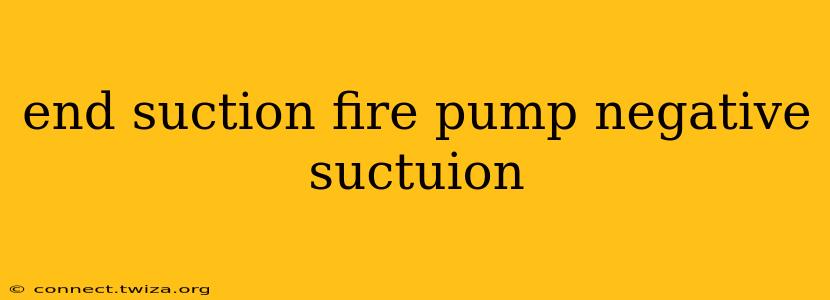End suction fire pumps are critical components in fire protection systems, providing the necessary water pressure to combat fires. However, operating these pumps with negative suction can lead to serious issues, impacting their performance and potentially jeopardizing life safety. This comprehensive guide explores the complexities of negative suction in end suction fire pumps, detailing its causes, consequences, and effective mitigation strategies.
What is Negative Suction in an End Suction Fire Pump?
Negative suction, also known as cavitation, occurs when the pressure at the pump's suction inlet drops below the vapor pressure of the liquid being pumped (usually water). This pressure drop causes the water to vaporize, forming vapor bubbles. As these bubbles travel through the pump impeller, they collapse violently, creating shock waves that can damage pump components, reduce efficiency, and even lead to pump failure. This is a significant problem for end suction fire pumps because their design is particularly sensitive to this issue. Unlike other pump types, the impeller's design and placement within the casing contribute to a higher susceptibility to cavitation.
Why Does Negative Suction Occur in End Suction Fire Pumps?
Several factors contribute to negative suction in end suction fire pumps:
- Insufficient Suction Head: This is the most common cause. If the water level in the supply source (e.g., water tank, reservoir) is too low relative to the pump's location, the pump struggles to draw in sufficient water, resulting in negative pressure at the inlet.
- Excessive System Friction Losses: High friction in the suction piping due to bends, restrictions, or excessive length can significantly reduce pressure at the pump inlet. Old or poorly maintained piping is a prime suspect here.
- High Pump Speed: Operating the pump at a speed higher than its design specifications can increase the demand for water beyond the supply capacity, contributing to negative pressure.
- Air Leaks in the Suction Line: Air leaks introduce non-condensable gases into the suction line, reducing the effective pressure and increasing the risk of cavitation.
- Clogged Suction Strainer: A clogged suction strainer restricts water flow, creating a pressure drop at the pump inlet.
What are the Consequences of Negative Suction?
The consequences of operating an end suction fire pump under negative suction conditions are severe:
- Pump Damage: Cavitation's shock waves erode pump impellers, casings, and other internal components, leading to premature wear and tear and costly repairs.
- Reduced Pump Efficiency: Cavitation reduces the pump's ability to deliver water at the required pressure and flow rate, compromising its firefighting effectiveness.
- Noise and Vibration: Cavitation generates excessive noise and vibration, indicating a serious problem requiring immediate attention.
- Pump Failure: In extreme cases, persistent negative suction can cause catastrophic pump failure, rendering the fire protection system inoperable during an emergency.
How Can Negative Suction be Prevented or Mitigated?
Preventing negative suction requires careful system design, proper maintenance, and vigilant operation:
- Ensure Adequate Suction Head: Properly position the pump relative to the water source to maintain a positive suction head. The system should be designed with sufficient static lift to avoid negative pressure conditions.
- Minimize System Friction Losses: Use properly sized piping with minimal bends and restrictions. Regular inspections and cleaning of the suction line can help maintain optimal flow.
- Operate the Pump Within its Design Parameters: Avoid exceeding the pump's specified speed and operating conditions to prevent overdemand.
- Regularly Inspect and Clean the Suction Strainer: Regularly inspect and clean the suction strainer to ensure unimpeded water flow. A clogged strainer is a common culprit.
- Check for Air Leaks in the Suction Line: Regularly inspect the suction line for any leaks. Repair or replace damaged sections promptly.
- Install a Vacuum Breaker: Vacuum breakers prevent the formation of a vacuum in the suction line, ensuring positive pressure.
- Proper Pump Priming: Ensure that the pump is properly primed before starting to eliminate air pockets in the suction line.
What are the Signs of Negative Suction?
Recognizing the signs of negative suction is crucial for preventing major issues. Look out for:
- Unusual Noise or Vibration: A change in the pump's typical sounds can indicate cavitation.
- Reduced Flow Rate: If the pump is not delivering the expected water flow, it may be due to cavitation.
- Lower than Expected Pressure: A drop in pressure suggests that the pump is not functioning efficiently.
- Visible Erosion or Damage to Pump Components: Inspect the pump for signs of erosion or damage which could be a direct consequence of cavitation.
By addressing the causes of negative suction and implementing preventive measures, you can ensure the reliable performance of your end suction fire pump and maintain the integrity of your fire protection system. Remember that the safety of lives and property depends on the proper functioning of this critical equipment.
